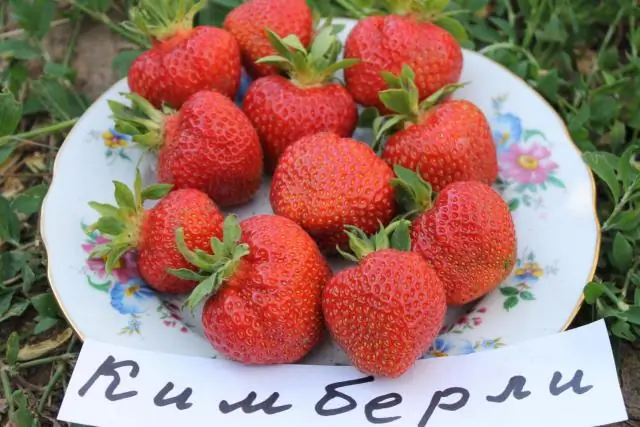
Table of contents:
- Author Bailey Albertson [email protected].
- Public 2024-01-17 22:26.
- Last modified 2025-06-01 07:32.
Royal harvest of strawberry Lord: all the features of the variety

Garden strawberries are a favorite berry of many. Thanks to the work of breeders, a lot of varieties have been bred, but the most common of them is Lord. The berries live up to their name: they are very large, juicy and, which is important for many gardeners, unpretentious. It is not surprising that the variety is very popular in Russia, since it is rather successfully cultivated even in the harsh conditions of the Altai Territory.
Content
- 1 How is strawberry different from strawberry?
-
2 Description of the strawberry variety Lord
- 2.1 Brief history
- 2.2 Characteristics of the yield and ripening of strawberry Lord (table)
- 2.3 What bushes and berries look like
- 2.4 Photo gallery: appearance of Lord strawberry berries
- 2.5 Advantages and disadvantages of the variety (table)
-
3 Planting and care
- 3.1 Site selection
- 3.2 Soil preparation
- 3.3 Scheme and landing time
-
3.4 Strawberry planting technologies
- 3.4.1 Chessboard
- 3.4.2 On ridges
- 3.4.3 Planting in holes
- 3.4.4 Video: the subtleties of planting strawberries
- 3.5 Watering
- 3.6 What feeding are necessary for Lord strawberries (table)
- 3.7 Video: tips for caring for garden strawberries
- 3.8 Regulation of the timing of the harvest
- 3.9 Other important care features
-
4 Reproduction
- 4.1 Antennae
-
4.2 Seeds
4.2.1 Photo gallery: seed propagation of strawberry Lord
- 4.3 Transplanting bushes
-
5 Diseases and pests
- 5.1 Table: Methods of Disease and Pest Control and Prevention
- 5.2 Photo gallery: how to recognize diseases and pests of strawberry Lord
-
6 Harvesting and storage of crops
- 6.1 How to pick berries correctly
- 6.2 Specificity of storage of strawberries Lord
- 7 Reviews of gardeners
How is strawberry different from strawberry?
Many people mistakenly call garden strawberries strawberries. So what is the difference? Strawberry bushes are taller and more powerful than strawberry bushes. Their stalks are straight and usually rise above the leaves. An important biological difference between strawberries is its monoeciousness. This means that her male and female flowers are located on the same plant, that is, she is self-fertile. Thanks to this, all planted strawberry bushes, unlike strawberries, will bear fruit. This provides a higher yield and larger berries.

Left - strawberry, right - strawberry
Description of the strawberry variety Lord
Short story
The first bush of the garden strawberry Lord was developed in the UK and became widespread. It is a perennial large-fruited variety of medium late ripening. It is versatile, that is, it is suitable for both industrial and home cultivation.
Characteristics of the yield and ripening of strawberry Lord (table)
| Yield | Lord is one of the most productive varieties. With a sufficient distance between plants (80-100 cm in one row), it gives a large harvest already in the 3rd year. In the 4th-6th year, you can collect up to 2-3 kg from the bush. |
| The number of peduncles on adult plants | Each year, the number of horns and peduncles on the bushes increases. On adult plants, there are up to 30 peduncles. |
| The number of berries on one peduncle | 10-15 large berries. |
| Cultivation period in one place without loss of yield | Up to 10 years old. |
| Berry ripening period | From late June to mid-July. |
What bushes and berries look like
The bushes are tall (35-60 cm, depending on the climatic conditions of the area) with straight, powerful stems. The plant has strong peduncles, but they also bend to the ground with a significant weight of berries. In this regard, Lord strawberries must be tied up, otherwise the peduncle may break. A very convenient way of tying up is to pull the cord along the rows and lay the peduncles on it.
The berries of the Lord strawberry variety have a rounded-elongated shape. Ripe berries turn bright red. They have a dense consistency, pleasant aroma and sweet taste. May have a sour taste in rainy summers. The formation of the taste characteristics of the berry occurs at the time of full ripening. Lord is a large-fruited variety: berries can reach a mass of 80-110 g.
Photo gallery: appearance of Lord strawberry berries
-

Berries of garden strawberry Lord - Large berries of a rounded-oblong shape
-

Lord strawberries on a saucer - Appetizing berries - a storehouse of vitamins
-

Strawberry Lord -
Heavy stalks with ripening berries should be tied up
-

Strawberry size Lord - There are real giants among the berries
-

Strawberry Lord - In hot weather, the color of ripe berries is darker
-

Ripe strawberries Lord - Deep red color - a signal of maturity
Advantages and disadvantages of the variety (table)
| pros | Minuses |
| Provides a sufficient number of whiskers for the propagation of bushes, but at the same time there is no surplus of them, which significantly reduces the complexity of care. | Those wishing to have this variety at home need to keep in mind that its bushes are powerful and require a decent "living space". Therefore, they need to be planted at a distance of at least 50 cm from each other. |
| Long fruiting period. | The varietal qualities of the Lord are manifested only with good feeding - four times per season. |
| Differs Lord and resistance to all kinds of pests and diseases. | |
| The Lord's peduncles are strong, tall, powerful. They hold the first berries well, bow to the ground only under a very heavy load. | |
| Winter hardiness of this variety is at an altitude. One layer of non-woven covering fabric (grade no lower than 60) is already enough to withstand short-term frost up to 5-8 degrees during spring frosts. | |
| This is a high-yielding variety, from one adult bush you can pick up to 2-3 kg of berries. | |
| Plantings with the Lord can be grown in one place for up to 10 years. |
Planting and leaving
Seat selection
Preferred for growing strawberries is a flat area, well-lit by the sun and as calm as possible. In such areas, you can get berries with a rich taste and color. Hilly places are less acceptable, as moisture quickly leaves them, and this culture requires a constantly moist upper (about 20 cm) layer of soil.
At the same time, wetlands or lowlands are completely unsuitable for growing strawberries. Stagnant water and lack of light will significantly spoil the crop. Not suitable for cultivation of strawberries and soils with high acidity, salt marshes and limestones.
Soil preparation
The essence of this process is as follows:
- Form the ridges a week before planting.
- The width of the ridge for large-fruited varieties is 80-100 cm with a distance between bushes 60-80 cm with planting in one row.
- The height of the ridges should be at the level of the walkway, raise them only in flooded areas.
- For seedlings, you need to make a hole or a line not in the garden bed to a depth of 30 cm.
- Fill it halfway with humus.
- Add 20-30 g of superphosphate and 100-150 g of wood ash or 15 g of potassium sulfate.
- Mix the soil with fertilizers.
Scheme and landing time
The optimal time for planting strawberries is August-September. Plants planted during this period have time to take root before frost and develop a root system. You can plant strawberries in early spring.
If you plant strawberries in late summer or early autumn, then you need to choose places that are freed from asparagus beans and peas, radishes, lettuce, onions, garlic, and herbs around the middle of summer. Also suitable predecessors are beets and carrots, but it is desirable that these were separate beds, planted "for summer consumption", because in September, when the main harvest of beets and carrots is harvested, it is too late to plant strawberries.
Strawberry planting technologies
Chess scheme
- The soil for planting is prepared in advance: they dig up, remove weeds, apply fertilizers, loosen and level.
- On the prepared soil, pull the cord and mark the places for the holes.
-
To prevent weeds from growing, the place for planting is covered with a film or roofing material, having previously cut holes for the plants.

Planting strawberries in a bed covered with a film The film protects against drying out of the soil, weeds and prevents contamination of berries
-
So that strawberry bushes do not turn into impassable jungle, at the time of planting, they should be placed in a checkerboard pattern, and not one after another in the garden, keeping the distance between the bushes 25-35 cm.

Chess bed of strawberries "Chess" bed of strawberries, covered with roofing felt
On the ridges
If the site is waterlogged, strawberries are grown on ridges or ridges. To do this, form a continuous fruitful strip 1 m wide, on both sides of which grooves are made to drain excess water.

Growing strawberries on the ridges in a waterlogged area
Landing in holes
-
The holes are dug so that the roots of the strawberry can freely fit in them.

Strawberry bush hole The size of the hole depends on the volume of the stems
- Long roots are shortened to 5 cm.
- If the seedling has many leaves, they are also removed, leaving 3-4 central leaves.
-
The seedlings are dipped in a clay mash (a mixture of clay and water in equal proportions), to which Kornevin is added.

Kornevin Kornevin - root growth stimulant
- The roots are straightened in the hole, carefully sprinkled with earth, slightly compacted.
-
When planting, make sure that the apical bud is at the level of the soil, and the roots are not exposed. Properly planted plants should not break out of the ground if they are easily pulled by the leaf.

Strawberry growth point The growth point or "heart" is located at the border of the root system and stems
- Strawberries are planted so that they are located in a small hole, and the water does not spread during watering.
-
After planting, the plants should be watered abundantly.

Watering strawberries when planting Wells must prevent water from spreading
-
If you did not use a film or roofing material, then immediately after planting the seedlings, it is better to mulch the soil.

Mulching strawberries Straw is a good mulch
Video: the subtleties of planting strawberries
Watering

Drip irrigation prevents the appearance of weeds, saves water consumption, and has a beneficial effect on the soil structure - and these are not all of its advantages.
What feeding are necessary for Lord strawberries (table)
| Application period | Top dressing |
| One week after planting seedlings | The ridges must be fed with wood ash (sprinkle around the bush, pour water, loosen). 15-20 g of ash is poured under each bush. |
| 2-4 days after the 1st feeding | Can be fed with complex mineral fertilizer (N: K: P in equal proportions). Follow the dosage strictly according to the instructions on the package: 15-20 g per 1 m of the garden or 3-4 g in each well. |
| 2-4 days after the 2nd feeding | Conduct feeding with infusion of mullein or bird droppings. For one part of fresh chicken manure, you need to take from 15 to 20 parts of water. |
In the future, top dressing should be done according to the same method in the following terms:
- in the spring, after cutting off old leaves;
- at the time of budding (extension of peduncles);
- after harvesting and pruning old leaves.
Video: tips for caring for garden strawberries
Harvest timing
Gardeners are able to transfer the ripening period of Lord strawberries using simple methods. If there is a need to get a harvest 1-2 weeks earlier, it is necessary to artificially raise the temperature of the air and soil in the garden bed, covering it with foil materials. Such a greenhouse will be effective from the moment the air warms up to -5 degrees and above. Until the frosts pass, the effectiveness of such a covering depends on its tightness. On sunny days, it is necessary to control the air temperature inside the greenhouse. It should not exceed +25 degrees.

Acceleration of strawberry ripening time with the help of film cover
When plants are in bloom, it is necessary to ensure that the pollinating insects have access to the flowers. To do this, open the sides of the greenhouse. Such manipulations are possible when the external air temperature is above +5 degrees. At the same time, the greenhouse is ventilated. In the absence of frost at night, the sidewalls can be left open.
You can postpone the ripening time of Lord strawberries by 2 weeks using an artificial "continuation of winter". The essence of this method is to maintain a low temperature in the garden for a longer time in order to slow down the beginning of the growing season. To do this, cover the bed covered with snow with a layer of straw or sawdust. These materials create the so-called thermal protection and the snow does not melt longer.
Other important care features
- To increase the yield, it is required to feed strawberries at least 3 times a year.
- Before and after the berries ripen, it is necessary to irrigate the soil well.
- In the southern regions, the variety increases its yield many times over. Under good weather conditions, strawberries can bloom a second time in early September in the middle Urals and in the Moscow region.
- To exclude the depletion of strawberries, it is necessary to timely remove flowering and cut the flower stalks.
- It is also recommended to remove the antennae of plants, since during the ripening period of berries, they will only take away strength and nutrients.

Pruning the strawberry whiskers helps the plant maintain strength during fruiting
Reproduction
The easiest and most effective way to breed strawberries is with a mustache. However, with increasing age of plants, it loses its effectiveness. Therefore, it is advisable to consider all possible breeding methods.
Mustache
With this method, young plants formed on the antennae and rooted in the ground are used as planting material. High-quality seedlings are the shoots of strong plants without signs of disease. Sometimes whole "garlands" can form on one antenna. However, it is advisable to select only the first two sockets for planting. During the first two years, with this method of propagation, Lord strawberries retain their varietal characteristics. In the future, this ability is gradually lost.

Convenient way of rooting a new outlet
Seeds
This method is much more time consuming. To ensure good germination of seeds, it is necessary to stratify them - to stand for a month at a low temperature (about +5 degrees). The seeds can then be sown. The most favorable period for this is January-March. This method is suitable for home use. Stratification can be carried out even more efficiently: cover already sown seeds with snow and leave them outside until the end of January. After that, bring it into the room and cover with foil, without removing the snow. Such hardening ensures friendly germination of seeds. The seeds must be lightly covered with earth, otherwise the sprouts may begin to fall. After all, their roots are still too weak.
Photo gallery: seed propagation of strawberry Lord
-

Strawberry seedlings - Grown strawberry seedlings, planted in separate pots
-

Stratification - Stratification of sown strawberry seeds under the snow
-

Strawberry seeds - Strawberry seeds
Transplanting bushes
Strawberry Lord requires replanting every 4 years. This is best done in September. During this period, there is no longer a strong heat, but it is still far from frost: there is time for rooting. The essence of the method is to dig out a bush and separate young bushes with their own roots from an adult plant. When planting, the growth point or "heart" must not be covered, otherwise the plant may die.

Only bushes with their own root system can be separated from the mother plant.
Diseases and pests
This variety almost does not suffer from gray rot and is not very much damaged by strawberry mites in comparison with other varieties. But even if the plant is sick, it can be saved.
Table: methods of combating diseases and pests and their prevention
| Disease / pest | Signs of defeat | Prevention | Treatment |
| Gray rot | The appearance of a fluffy grayish bloom on stems, leaves and berries. The affected parts of the plant dry out and die off over time. |
|
|
| Strawberry mite |
|
|
Spraying with solutions of acaricides: Actellik (dilute 1 ml of the drug in 600 ml of water), Kemifos (10 ml per 10 l of water), Fufanon (5 l per 10 m 2) and others. |
| Stem nematoda |
|
|
Application of fungicides: Captan (0.5% solution), Auparen (0.4% solution), Horus and others. |
| White spot (septoria) |
|
|
Spraying with Nitrafen or Bordeaux liquid (400 g per 10 l of water). |
Photo gallery: how to recognize diseases and pests of strawberry Lord
-

Stem nematode - Stem nematode
-

Strawberry leaves affected by strawberry mites - Strawberry leaves affected by strawberry mites
-

Gray rot on strawberries - Gray rot on strawberries
-

White spot (septoria) - White spot
Harvesting and storage
How to pick berries correctly
- Harvest at the technical maturity stage (2 days before full ripening): this will increase the keeping quality of the berries.
- Do not tear off the green caps.
- Protect the harvested berries from sunlight. For this purpose, harvesting is preferably carried out in the morning (after the berries have dried from the dew) or in the evening, before sunset.
- Sort healthy, dense, crumpled and moldy berries.
Strawberry storage specifics Lord
- Berries of the variety are well stored and transportable enough.
- The optimal container for strawberries is flat boxes made of plastic or wood, small and wide baskets, woven of wood chips.
- It is advisable to put hygroscopic material at the bottom of the container for storing strawberries: porous paper, napkins, textiles.
- You cannot wash berries before storing them.
- Plastic containers impair the taste of berries.
- The speedy cooling of the berries after picking up to +2 degrees extends their fresh storage life up to 4 days.
- Strawberries are stored at room temperature for 1 day.
- Strawberries intended for freezing must be washed and the tails removed.
- Instant freezing is best done by laying out the berries in one layer, after which the hardened strawberries can be poured into a container, avoiding sticking of berries.

Frozen strawberries provide vitamins
Gardeners reviews
The garden strawberry variety Lord has many advantages. The main one is high yield and large size of berries. Try to plant Lord strawberries in your garden, and yourself will appreciate all its advantages.
Recommended:
Garden Strawberry Marmalade - Description Of The Variety, Rules Of Care And Other Important Nuances + Photo

A detailed description of the variety of garden strawberry Marmalade. Pros and cons. Planting and growing rules. Pest and disease control. Variety reviews
A Variety Of Garden Strawberries (or Strawberries) Kimberly - Description, Care And Other Features + Photo

Information on planting and breeding of Kimberley strawberries (strawberries), care, planting, harvesting. Description of the variety. Reviews of gardeners about Kimberly strawberries
Garden Strawberry Victoria - Features Of The Variety And Important Nuances Of Growing + Photo

Strawberries or strawberries? And also about Victoria over common sense
Chamora Turusi Variety Of Garden Strawberries - Features, Care And Other Important Aspects, The Difference Between Strawberries And Garden Strawberries + Photo

Everything about the Chamora Turusi strawberry variety: from planting and care to picking berries. Productivity, terms of fruiting, reviews of gardeners
Everything About Garden Strawberries (strawberries) Queen Elizabeth: Description Of The Strawberry Variety, Planting, Care And Other Aspects + Photo

Description of the variety of remontant strawberries Queen Elizabeth, often called strawberries: pros and cons, features of fruiting, planting, care, photos and reviews
